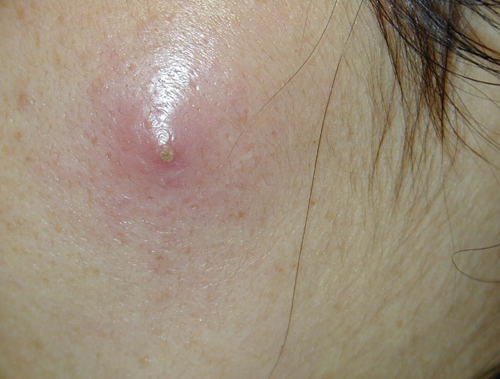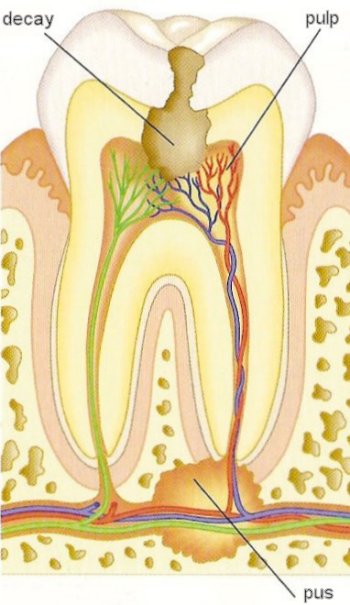abscess

A small skin abscess on the face.

An abscess on a tooth.
An abscess is a localized collection of pus in any part of the body, surrounded by an inflamed area which forms a well-defined wall (abscess cavity). Abscesses are commonly caused by infection with pus-forming (pyogenic) bacteria, often staphylococci, but may also result from the intrusion of a foreign body.
Cause
Abscesses occur when an area of tissue becomes infected and the body's immune system tries to fight it. White blood cells, or leukocytes, move through the walls of the blood vessels into the area of the infection and collect within the damaged tissue. During this process, pus forms. Pus is the build up of fluid, living and dead white blood cells, dead tissue, and bacteria or other foreign substances.
Abscesses can form in almost every part of the body and may be caused by infectious organisms, parasites, and foreign substances. Abscesses in the skin can be easily seen, and are red, raised, and painful. Abscesses in other areas of the body may not be obvious, but if present they may cause significant organ damage. Common sites include the breast and gums. Rarer sites include the liver and the brain.
Skin abscess
Also known as cutaneous or subcutaneous abscesses, skin abscesses are fairly common. They are caused when an infection leads to pus and infected material collecting in the skin. Skin abscesses may follow a bacterial infection, commonly an infection with staphylococcus. They can develop after a minor wound, injury, or as a complication of folliculitis or boils. Skin abscesses may occur anywhere on the body and may affect people of all ages.
An abscess can prevent deeper tissues from functioning properly. The infection may spread locally or throughout the body. The spread of infection through the bloodstream may cause severe complications.
Symptoms of a skin abscess
Exams and tests
A doctor can diagnose the condition based on the appearance of the area. A culture or examination of any drainage from the lesion may help identify what organism is causing it.
Treatment for a skin abscess
The goal of treatment is to cure the infection. The doctor may cut and drain the abscess to clean the area and control the infection. Antibiotics are given to control the infection.
Heat (such as warm compresses) may speed healing, reduce inflammation, and make the area feel better. Raise the affected part to reduce swelling and inflammation.
Tooth abscess
Also known as a dental or periapical abscess, a tooth abscess is a collection of pus resulting from bacterial infection of the center of a tooth and is a complication of tooth decay. A tooth abscess may also result from trauma to the tooth, such as when a tooth is broken or chipped. Openings in the tooth enamel allow bacteria to infect the center of the tooth (the pulp). Infection may spread out from the root of the tooth and to the bones supporting the tooth.
Infection results in a collection of pus (dead tissue, live and dead bacteria, white blood cells) and swelling of the tissues within the tooth. This causes a painful toothache. If the root of the tooth dies, the toothache may stop, unless an abscess develops. This is especially true if the infection remains active and continues to spread and destroy tissue.
Symptoms of a tooth abscess
Gnawing or throbbing pain
Sharp or shooting pain
Exams and tests
The patient will feel pain when the dentist taps the tooth. Biting or closing the mouth tightly also increases the pain. The gums may be swollen and red and may drain thick material.
Treatment for a tooth abscess
The goals of treatment are elimination of the infection, preservation of the tooth, and prevention of complications. Antibiotics may be given to fight the infection. Warm salt-water rinses may be soothing. Over-the-counter pain relievers may relieve the toothache and fever. Do not place aspirin directly over the tooth or gums because this increases irritation of the tissues and can result in mouth ulcers.
Root canal therapy may be recommended in an attempt to preserve the tooth. The center of the tooth, including the nerve and vascular tissue (pulp), is removed along with decayed portions of the tooth. The root and surface of the tooth remain in place. The cavity that is created in the core is filled and repaired, and a crown may be placed over the tooth.
Surgical drainage of the abscess or extraction of the affected tooth may be necessary.
Cerebral abscess
The brain and its meninges have a low resistance to infection and a cerebral abscess is liable to follow any penetration of these by microorganisms. The condition is fatal unless relieved by aspiration or surgical drainage.


